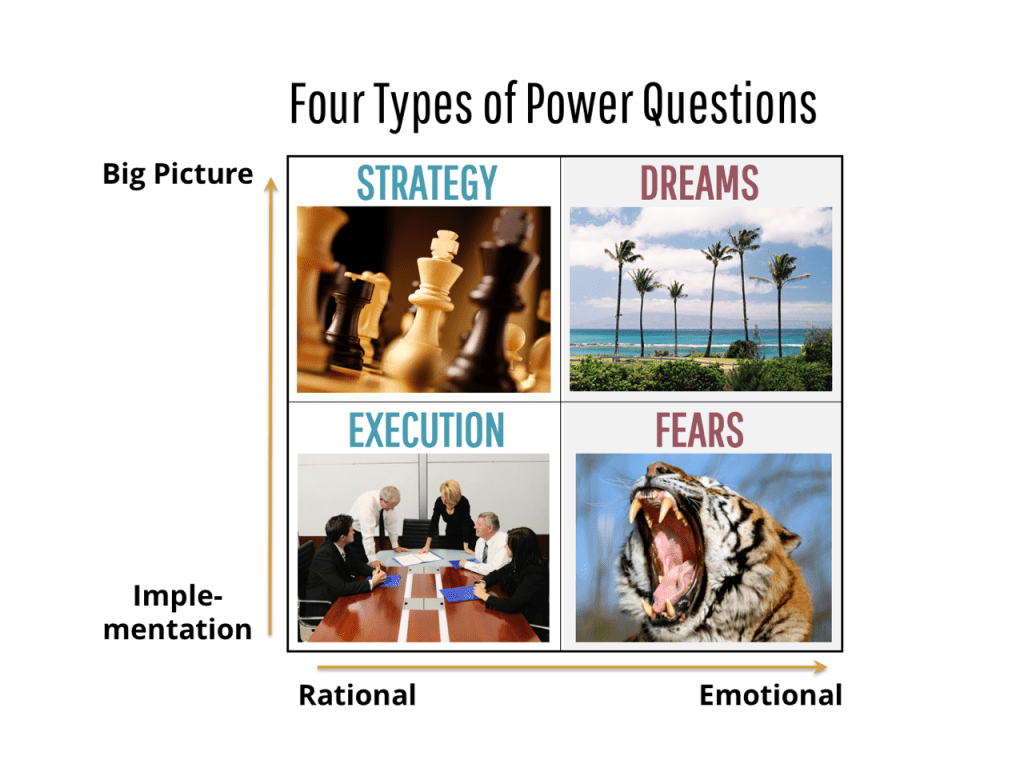
Four Types of Power Questions
Reframing Work & Life #1: The Power Questions Matrix
Jerry Panas and I coined the term “Power Questions” in our book of the same title. Somewhat to our amazed delight, it went on to become a global best-seller that has been translated into 21 languages. Power Questions, put simply, are open-ended questions that engage the other person in a thought-provoking conversation. They uncover the real issues that need to be discussed. They help you get to the root cause of important problems and dilemmas. They reframe the conversation in new, transformative ways. They surprise and, often, delight.
While there are many different types of Power Questions, the following matrix sets out four important areas in which you should be asking thoughtful questions. Whether you’re talking to a client, your manager, a colleague—or your friends and family—these four question quadrants will, together, yield a lode of pure gold. There are two key dimensions or axes that define the four quadrants. First, are you focusing on implementation—the details—or on the big picture? So that’s one distinction. With a colleague, that might mean talking about how they are going to handle a tough project they’ve just been assigned—implementation—versus discussing their how that project fits into the company’s strategy—the big picture.
There are two key dimensions or axes that define the four quadrants. First, are you focusing on implementation—the details—or on the big picture? So that’s one distinction. With a colleague, that might mean talking about how they are going to handle a tough project they’ve just been assigned—implementation—versus discussing their how that project fits into the company’s strategy—the big picture.
The second distinction is this: Are you in the realm of the rational or the emotional? So with a client, that might mean discussing how your technology solution can help them improve customer service—a rational question—versus asking what concerns or fears they may have are about using a new solution, which delves into the emotional, or personal realm.
In the lower left Execution quadrant, you’ll ask rational questions about implementation: “How are you going to do that” or “What is your timing?” and so on.
But often, you also need to move up to the Strategy quadrant in order to really understand the context for what the other person is trying to accomplish. If a client asks for help clarifying organizational roles and responsibilities, you would follow up with a question or two in the Strategy quadrant to clarify the backdrop to the request.
In the Strategy quadrant, you might ask questions about higher-level goals: “Why do you want to do that?” or “What are your most important priorities for this year?”
But remember, we are most alive and animated when our emotions are engaged, so you must also understand the emotional or personal side of the issue. In the upper-right Dreams quadrant you might ask questions like, “What legacy do you hope to leave?” or “What are you working on that you’re most excited about?”
Finally, in the lower right Fears quadrant you need to ask questions about concerns, anxieties, and frustrations—things that could get in the way of dreams and aspirations. For example, “What parts of your implementation program have been most frustrating?” Or, “What part of your job is most challenging right now?”
For most of us, it feels safer to stick to the Strategy and Execution quadrants. But, the most extraordinary conversations can develop from questions on the right side of the matrix. During 2018 I spent much of the year developing a new eLearning program called Building Relationships That Matter. One night, I previewed the Power Questions module with a young friend. A week later, he called me, and said, “You know, I used some of those dreams questions in a discussion with my wife last night, and—well, we had an absolutely amazing, heartfelt conversation that drew some really important issues to the surface for the very first time.”
It really works.